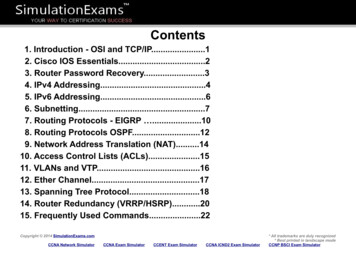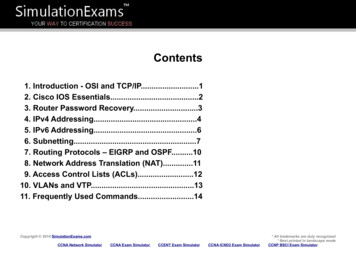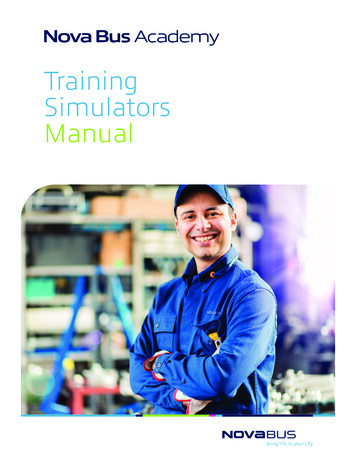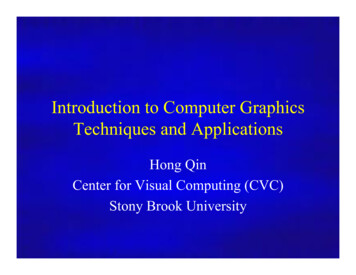
Transcription
Network Simulator Test Engine for Huawei eNSP and Cisco GNS3ByTan Cian ShuA PROPOSALSUBMITTED TOUniversiti Tunku Abdul Rahmanin partial fulfillment of the requirementsfor the degree ofBACHELOR OF INFORMATION SYSTEM (HONS)BUSINESS INFORMATION SYSTEMFaculty of Information and Communication Technology(Perak Campus)JAN 2014
UNIVERSITI TUNKU ABDUL RAHMANREPORT STATUS DECLARATION FORMTitle: Network Simulator Test Engine for Huawei eNSP and GNS3Academic Session: JAN 2014I(CAPITAL LETTER)declare that I allow this Final Year Project Report to be kept inUniversiti Tunku Abdul Rahman Library subject to the regulations as follows:1. The dissertation is a property of the Library.2. The Library is allowed to make copies of this dissertation for academic purposesVerified by,(Author’s signature)(Supervisor’s signature)Address:Supervisor’s nameDate:Date:ii
DECLARATION OF ORIGINALITYI declare that this report entitled “NETWORK SIMULATOR TEST ENGINE FORHUAWEI ENSP AND CISCO GNS3” is my own work except as cited in thereferences. The report has not been accepted for any degree and is not beingsubmitted concurrently in candidature for any degree or other award.Signature:Name:Date:Bachelor of Information Systems (HONS) Business Information SystemFaculty of Information and Communication Technology (Perak Campus), UTARiii
ACKNOWLEDGEMENTSI would like to take this opportunity to express my sincere thanks and appreciation tomy supervisors, Dr. Choo Peng Yin who has given me this bright opportunity toengage in a commercialized and having user-base IT project. This Final Year Projecthad brought me advantages in my internship and future career as this Project hadadded value when interview by companies for internship. I have learned a lot of newthings while doing this project. Whenever I face problem, Dr. Choo always willprovide guidance and suggestion regarding the problem issues. His invaluable adviceand consideration throughout the progress of doing this Final Year Project are greatlyappreciated. A million thanks to you.Besides, I would like to thanks my academic advisor, Mr. Albert Yong who given mea lot of useful advices regarding my final year project, future career and studies inuniversity. Finally, I must say thanks to my parents and my family for their love,support and continuous encouragement throughout the course.Bachelor of Information Systems (HONS) Business Information SystemFaculty of Information and Communication Technology (Perak Campus), UTARiv
ABSTRACTSNetwork Simulator Test Engine is defined as software that enables the lab trainer orinstructor to conduct practical tests or interactive guided lab with network simulators(Huawei eNSP and Cisco GNS3). This test engine will able to help user to debug andgive instance feedback on configuration done in eNSP. Besides, this project also ableto help lecturers to perform guided lab and practical test. Furthermore, this projectalso included socket programming to send the result marks of student to a server PC(lecturer), this features allow lecturer to obtain their student marks instantly and keeptrack of their progress during each exercise or test.Purpose of this software is mainly to will improve the teaching quality and studentlearnability regarding networking subject. Besides, it also will reduce the workload oflecturer when conduction lab or practical test. This software is stand-alone softwarewhich can execute on windows platform and do not require to modifying the HuaweieNSP and Cisco GNS3 software.Evolutionary prototyping methodology is used in this project as this is a newly idea,therefore it required rapidly develop a prototype to show clearer concept of thisproject. Since rapid application development (RAD) approach is more suitable for thisproject to support poof-of-concept and able to get early stage feedback from usersbefore full completing of the project. After repeatedly went through the phases suchas planning, analysis, design, implementation, and testing, the prototype will becomefully functional software that fulfills the requirement or objective of this project.Bachelor of Information Systems (HONS) Business Information SystemFaculty of Information and Communication Technology (Perak Campus), UTARv
TABLE OF CONTENTSTITLEiSTATUS DECLARATION FORMiiDECLARATION OF ORIGINALITYiiiACKNOWLEDGEMENTSivABSTRACTvTABLE OF CONTENTSviLIST OF TABLESviiiLIST OF FIGURESixLIST OF ABBREVIATIONSxCHAPTER 1: em Statement31.4Project Scope41.5Project Objective51.6Impact, significance and contribution6CHAPTER 2: LITERATURE REVIEW2.1Literature Review72.1.1Review on Linear learning/Computer based learning (E-Learning)72.1.2Review on Cisco Packet Tracer Activity Wizard (version 5.3.3)92.1.3Review on Cisco Packet Tracer (version 6 beta)112.2Strength and weakness analysis2.3Comparison features of similar product with Network Simulator Test Engine 15Bachelor of Information Systems (HONS) Business Information SystemFaculty of Information and Communication Technology (Perak Campus), UTAR14vi
CHAPTER 3: METHODOLOGY3.1Methodology and tools163.2Implementation Issues and Challenges173.3Project Timeline173.3.1Project Timeliness for Project One183.3.2Project Timeliness for Project Two193.4Requirement specifications203.4.1User requirement203.4.2General Flowchart213.4.3Use Case Diagram263.5Development Tools273.5.1Hardware273.5.2Software28CHAPTER 4: TEST RESULT4.1Feedback from Users294.2Prototype Objective Achieved324.3Sample Screenshot of Network Simulator Test Engine Prototype33CHAPTER 5: DESIGN5.1System Design355.2Interface Design35CHAPTER 6: IMPLEMENTATION6.1Implementation506.2Software Installation506.2.1Installation of Microsoft Visual 2010 Professional506.2.2Installation of Huawei eNSP (Network Simulator)51Bachelor of Information Systems (HONS) Business Information SystemFaculty of Information and Communication Technology (Perak Campus), UTARvii
6.2.3Installation of GNS3 (Network Simulator)52CHAPTER 7: TESTING7.1System Testing547.2Create Lab Exercise547.3Open Created Lab Exercise557.4Create Test Question557.5Open Created Test Question567.6Check Student Page Functionality577.7Check Server Functionality58CHAPTER 8: PROJECT IMPACT AND CONTRIBUTION8.1Project Impact and Contribution59CHAPTER 9: CONCLUSION9.1Conclusion64BIBLIOGRAPHY36APPENDIX AFeedback Form of PrototypeA-1APPENDIX BScreen captured of Testing ResultA-2APPENDIX CSoftware User GuideA-3Bachelor of Information Systems (HONS) Business Information SystemFaculty of Information and Communication Technology (Perak Campus), UTARviii
LIST OF TABLESTable NumberTitlePageTable 2.1Change log of Cisco Packet Tracer version 6 beta12Table 2.2Strength and weakness of CBT and Packet Tracer14Table 2.3Features comparison between similar products15Table 3.1Software required by users20Table 3.2Laptop Hardware Specification27Table 3.3Laptop Software Specification28Table 4.1Objective Achieved by Prototype32Table 5.1Description of Main Form36Table 5.2Description of Student Page38Table 5.3Description of Test Question40Table 5.4Description of Lecturer Page41Table 5.5Description of Instruction Tab43Table 5.6Description of Load Topology and Configuration files45Table 5.7Description of Test Creation Tab46Table 5.8Description of Test Question Creation47Table 5.9Description of Server Tab49Table 7.1Create Lab Exercise Test Table54Table 7.2Open Created Lab Exercise Test Table55Table 7.3Create Test Question Test Table55Table 7.4Open Created Test Question Test Table56Table 7.5Student Page Functionality Test Table57Table 7.6Server Functionality Test Table58Bachelor of Information Systems (HONS) Business Information SystemFaculty of Information and Communication Technology (Perak Campus), UTARix
LIST OF FIGURESFigure NumberTitlePageFigure 2.1Assessment item and points had achieved10Figure 2.2Instruction gives by lecturer10Figure 2.3Activity Wizard of Cisco Packet Tracer version 613beta (Cisco)Figure 3.1System Development Life Cycle of Evolutionary16Prototyping MethodologyFigure 3.2Gantt chart for Final Year Project I18Figure 3.3Gantt chart for Final Year Project II19Figure 3.4Main page design of Test Engine22Figure 3.5Configuration page of Test Engine23Figure 3.6General System Flowchart of Test Engine (student24version)Figure 3.7General System Flowchart of Test Engine (lecturer25version)Figure 3.8Use Case Diagram26Figure 4.1Graphs shows the feedback of UTAR students30regarding project prototypeFigure 4.2Graphs shows the feedback of HCDA trainee31regarding project prototypeFigure 4.3Test Result of Network Simulator Test Engine33PrototypeFigure 4.4Server page that record list of students’ marks34Figure 5.1Main Form Interface Design35Bachelor of Information Systems (HONS) Business Information SystemFaculty of Information and Communication Technology (Perak Campus), UTARx
Figure 5.2Student Page Interface Design37Figure 5.3Test Question Interface Design39Figure 5.4Lecturer Page Interface Design41Figure 5.5Instruction Tab Interface Design42Figure 5.6Load Topology and Configuration files Interface44DesignFigure 5.7Test Creation Tab Interface Design45Figure 5.8Test Question Creation Interface Design47Figure 5.9Server Tab Interface Design48Bachelor of Information Systems (HONS) Business Information SystemFaculty of Information and Communication Technology (Perak Campus), UTARxi
LIST OF ABBREVIATIONSACLAccess Control ListCBLComputer Based LearningCBTComputer Based TrainingDHCPDynamic Host Configuration ProtocoleNSPEnterprise Network Simulation PlatformGNS3Graphical Network SimulatorHCDAHuawei Certified Datacom AssociateHWICHigh-Speed WAN Interface CardHSRPHot Standby Router ProtocolIOSInternetwork Operating SystemIPInternet ProtocolLANLocal Area NetworkLTSLong Term SupportNICNetwork Interface ControllerOSOperating SystemPCPersonal ComputerRADRapid Application DevelopmentWBTWeb Based TrainingBachelor of Information Systems (HONS) Business Information SystemFaculty of Information and Communication Technology (Perak Campus), UTARxii
Chapter 1: Introduction1.1 IntroductionIn the context of this project, a “Network Simulator Test Engine” is defined assoftware that enables the lab trainer or instructor to conduct practical tests orinteractive guided lab with network simulators (Huawei eNSP and Cisco GNS3). Thistest engine will able to help user to debug and give instance feedback on configurationdone in eNSP. Besides, this test engine also able to help lecturers to perform guidedlab and practical test on eNSP. Currently, eNSP does not support those functions (testand guided lab) and those functionalities will have great impact to lecturers, studentsand others eNSP (and GNS3) users. With this interactive guided lab, user will find itmore interesting and easy to learn during practical session since user able to know thecorrectness of their works and the test engine also will notify lecturers regardingwhich students is unable to follow the teaching pace. This will improve the teachingquality and student learnability regarding networking subject.During practical test or lab test, lecturer able to prepare question and let student totake the assessment by using this test engine. Student only required to open theinstruction that pre-prepared by lecturer and start doing the assessment. Student ableto check their answer and get instance feedback on the correctness of what they havedone. On the other hand, student result or marks will automatically sent to lecturerclient computer over a LAN connection and lecturer able to export student result toexternal formal such as PDF or Excel. This function will reduce the workload oflecturer which they don’t required to walk around and mark down every individualstudent marks.Bachelor of Information Systems (HONS) Business Information SystemFaculty of Information and Communication Technology (Perak Campus), UTAR1
Chapter 1: Introduction1.2 MotivationThe main aims of this project is to develop a software that help to solve thedifficulties process of conducting lab and practical test using Huawei eNSP and GNS3.Currently both network simulator eNSP and GNS3 does not provide the checking andinteractive lab functionality, this project will create stand-alone software that able tocheck the correctness of user works, provide interactive guided lab to improvelearning process regarding networking courses and let users having better experiencein using network simulator like Huawei eNSP and GNS3.Moreover, this project also will ease the process of conducting HCDA (HuaweiCertified Datacom Associate) training program. As HCDA training program durationis quite short, and trainers have to rush in order to finish all teaching materials in theshort period, without the checking ability of trainee works, it will consume a lot oftime during the process of troubleshooting all trainee works. This project will giveusers instance feedback regarding their correctness of works.Last but not least, this project provides marks registration which means this softwareable to sent users current marks to a server PC (lecturer or trainer PC). This softwareallows lecturers or trainers to keep track of students or trainees progress and approachto specific person who unable to solve the problem on time.Bachelor of Information Systems (HONS) Business Information SystemFaculty of Information and Communication Technology (Perak Campus), UTAR2
Chapter 1: Introduction1.3 Problem StatementAfter some analysis and research on similar product in the market such as PacketTracer version 5.3.3 for IT in the literature review of Chapter 2, Packet TracerActivity Wizard did provides good assessment functionalities in which it allow user tocreate a networking scenarios for practical test purpose. It able to give instancefeedback to user regarding which assessment item is correct or wrong. However, itdoesn’t provide guidance for user and instruction given by Packet Tracer is in lessinteractive ways. For instance, it doesn’t have the functionality to provide step bystep guided lab instruction and give support during mistake made by user.Besides, Packet Tracer is not able to communicate to real devices like eNSP andGNS3 does. For example, eNSP and GNS3 allow user to connect a real router to thenetwork simulator and let the virtual router communicate with the real router. Sincethere is a demand for others network simulator tools like eNSP and GNS3, we cannotsolely depend on Packet Tracer. Therefore, there is a need to for this project toincrease the learning process of using network simulator tools like Huawei eNSP andGNS3 since they does not provide the checking functionalities like what PacketTracer does.Bachelor of Information Systems (HONS) Business Information SystemFaculty of Information and Communication Technology (Perak Campus), UTAR3
Chapter 1: Introduction1.4 Project ScopeThis project is to develop standalone software that can perform the functionality ofchecking networking configuration in eNSP, guided lab with interactive videoinstruction to users and student marks registration module which will send studentsmarks or task status to lecturer computer to notify lecturer regarding the progress andmarks of students without the needs of modifying the eNSP software code.This project will be developed using visual basic programming language because itsuitable for rapid application development (RAD) approach. This project is able toinstall and execute in windows base operation system such as Window XP, Vista, and7 without the needs of extra hardware.Bachelor of Information Systems (HONS) Business Information SystemFaculty of Information and Communication Technology (Perak Campus), UTAR4
Chapter 1: Introduction1.5 Project Objective1.5.1Able to read in input generated by eNSP and GNS3 and compare with the preloaded sample answer then show the result to user.1.5.2Written Test module which allows lecturers to create Multiple ChoiceQuestion and Text input question as a package with practical labs. Studentsanswer will be automatically check by system after they submit their answer.Calculated marks will sent to Server.1.5.3Lecturers able to choose initial topology network, answer topology networkand lectures also able to choose which assessment items to be assessed forpractical test mode.1.5.4Connectivity testing between two nodes. Able to check whether end devicesare connected to each other with correct cables.1.5.5Student marks registration module which will sent students marks or taskstatus to lecturer computer to notify lecturer regarding the progress and marksof students.1.5.6Lecturers are able to get students marks immediately during or directly afterthe test and able to export to external format (e.g. PDF or Excel).Bachelor of Information Systems (HONS) Business Information SystemFaculty of Information and Communication Technology (Perak Campus), UTAR5
Chapter 1: Introduction1.6 Impact, significance and contributionThis project will have great impact to education field regarding networking. Currently,there is no similar test engine product that able to check the work result of networksimulator eNSP and GNS3. By having this software, students who are in networkingfield will have better experience in networking since having more interactive lab andchecking function that allow student to get instance feedback regarding their workprogress. This software will increase teaching quality among university and studentlearnability regarding networking subject will also be increased.Besides, this project also will reduce the heavy workload of lecturers. With the help ofthis software, lecturers do not have to waste a lot of precious time on troubleshootingand checking students work. Lecturers also able to get rid of repeating similarpractical lab process and change to a more interactive practical lab process by usingthis software.Lastly, this project will contribute to world community by sharing this new idea canbe added to network simulator such as Huawei eNSP and GNS3 to increase the valueof the software as a network simulator. A network simulator is mainly used foreducation, training and testing purpose, it will be better if the network simulators havethe functionality of checking of works and instance feedback of their answer. Thiswill also increase the interest of pupil regarding networking and attract more users touse the network simulator.Bachelor of Information Systems (HONS) Business Information SystemFaculty of Information and Communication Technology (Perak Campus), UTAR6
Chapter 2: Literature Review2.1 Literature Review2.1.1Review on Linear learning/Computer based learning (E-Learning)Computer based learning (CBL) is using of computers as a main component of the elearning environment, for instance, in a place or venue which computers are used foreducational purposes. This concept can be view as being unique from the use ofcomputer in different ways where learning is at least a peripheral element of theexperience. (Dr.Sivanthi et al., 2010)Computer based training (CBT) refers to self-paced learning activities assessablethrough a computer or other devices such as portable handheld devices. It can beinstructor-led and includes media in different forms. For example, animation, audio,image, streaming video and text. CBT mostly presents it content in a linear format anddelivers it content via CD-ROM. Due to this reason; CBT is always used to teachstatic processes like completing mathematical equations or using software. Computerbased training and Web Based Training (WBT) can be used interchangeably, the maindifference is that WBTs are delivered using a web browser via Internet while CBTsare typically delivered via CD-ROM. (Dr.Sivanthi et al. 2010)Assessing learning in a CBT is often comes from various form such as multiplechoice questions which can be easily marked by a computer. Others good examplesare interactive means, radio button, drag-and-drop functionality and simulation.Assessments are be easily marked and recorded via online software. The software isable to provide instance feedback, completion status to users and users usually areable to print a hardcopy of their result in the form of certificates. (Dr.Ravichandran etal. 2010)Bachelor of Information Systems (HONS) Business Information SystemFaculty of Information and Communication Technology (Perak Campus), UTAR7
Chapter 2: Literature ReviewCBTs provide extraordinary learning methodology via learning stimulus which isdifferent from traditional learning methodology such as instruction, textbook andmanual. For instance, CBTs provide user-friendly solutions for fulfilling therequirement of continuing education. Students are able to acquire more knowledgeand skills through these methods which are much more conducive to individuallearning preferences, instead of limiting students to reading printed manuals orattending courses. (Dr.Sivanthi et al. 2010)CBTs are good choices to improve or enhance the learning process by includingvideos or animations in learning materials. Besides, CBTs is able to distribute to awide range of users easily and at low cost once the development is done.(Dr.Ravichandran et al. 2010)However, CBTs impose some disadvantages as well. During the creation of efficientand effective CBTs requires large number of resources. The development tools forCBTs such as Flash and Adobe Director is more complex and subject to capability ofteacher able to use it. Moreover, CBTs will limit the content that able to present andassessment that able to perform when there is lack of human interaction. Nowadays,many learning or educational organizations are began to use smaller CBT/WBTactivities which include interactive components and online discussion as part of an elearning program. (Kanev et al., 2009)Bachelor of Information Systems (HONS) Business Information SystemFaculty of Information and Communication Technology (Perak Campus), UTAR8
Chapter 2: Literature Review2.1.2Review on Cisco Packet Tracer Activity Wizard (version 5.3.3)Cisco Packet Tracer is a network simulator which have activity wizard, an assessmenttool that allow user to create a networking scenarios for practical test purpose. It ableto give direct feedback to user regarding which assessment item is correct or wrong.However, it doesn’t support the function of providing guidance for user andinstruction give is in word form which is less interactive. Besides that, Cisco PacketTracer is unable to send assessment marks of individual to specify client or server,lecturers are require to approach to every individual student to record down theirsmarks.Furthermore, if unfortunately some problems occur during the assessment time forinstance, system crash or computer restarted. Student might have to redo theassessment since Packet Tracker does not provide the ability to save their marks. Thisbrings a lot of problems to both lecturers and students. Students have to requestlecturer to help them mark down this current marks in the middle of practical test incase anything happened. This process had increased the workload of lecturers andstudents are unable to concentrate on the assessment. The following figure 2.1 and 2.2showing pictures of activity wizard.Bachelor of Information Systems (HONS) Business Information SystemFaculty of Information and Communication Technology (Perak Campus), UTAR9
Chapter 2: Literature ReviewFigure 2.1 Assessment item and points had achieved (Cisco)Figure 2.2 Instruction gives by lecturer (Cisco)Bachelor of Information Systems (HONS) Business Information SystemFaculty of Information and Communication Technology (Perak Campus), UTAR10
Chapter 2: Literature Review2.1.3Review on Cisco Packet Tracer (version 6 beta)A latest version 6 beta of Cisco Packet Tracer has been release in year 2013; it is animproved version of 5.3.3 with new features such as IOS 15, HWIC-2T, HWIC-8Amodules, 3 new Cisco routers and most important features that related to this projectis improvement on Activity Wizard which this project will benchmark with. However,this project proposal started before the release of Cisco Packet Tracer version 6 betatherefore the primary comparison of this project will base on version 5.3.3.Improvement made on Activity Wizard in version 6 beta will be considered for futureenhancement of this project. The table below show the change log Cisco PacketTracer version 6 beta.Bachelor of Information Systems (HONS) Business Information SystemFaculty of Information and Communication Technology (Perak Campus), UTAR11
Chapter 2: Literature ReviewNew features of Cisco Packet Tracer (version 6 beta)General Improvements on Activity WizardImprovement Improvements on Variable Manager Support current LTS version of Ubuntu and stoppedsupport for Fedora IOS 15 HWIC-2T and HWIC-8A modules CAB-HD8-ASYNC cable IPv6 in IP Configuration under Desktop Terminal server for routers PC Firewall for IPv4 and IPv6 Servers with 2 NICs Circling toolProtocol HSRP for IPv4 and IPv6Improvement IPv6 DHCP IPv6 tunnel over IPv4 IPv6 DHCP binding Send command for routers ACL sequence numbers Routers:New Devices-Cisco 1941-Cisco 2901-Cisco 2911Table 2.1 Change log of Cisco Packet Tracer version 6 betaBachelor of Information Systems (HONS) Business Information SystemFaculty of Information and Communication Technology (Perak Campus), UTAR12
Chapter 2: Literature ReviewFigure 2.3 Activity Wizard of Cisco Packet Tracer version 6 beta (Cisco)Bachelor of Information Systems (HONS) Business Information SystemFaculty of Information and Communication Technology (Perak Campus), UTAR13
Chapter 2: Literature Review2.2 Strength and weakness analysisStrengthWeaknessComputerProvide user-friendly solutionsRequired large number ofBasedsuch as interactive menuresourcesEnhance the learning process byUnable to embedded intoproviding video or animationexternal software and performLearning(CBT)practical assessment baselearningPacketProvide direct feedback to userUnable to send assessmentTracerregarding correctness ofmarks of individual to specifyActivityassessment itemclient or serverWizardAble to provide goodUnable to provide interactive(5.3.3)connectivity test between 2 nodeslearning environmentIf system crash during theassessment, user have to restartthe assessment.Table 2.2 Strength and weakness of CBT and Packet TracerBachelor of Information Systems (HONS) Business Information SystemFaculty of Information and Communication Technology (Perak Campus), UTAR14
Chapter 2: Literature Review2.3 Comparison features of similar product with Network Simulator Test EngineFeaturesPacket TracerNetworkActivity WizardSimulator Test(version 5.3.3)Engine Assessment duration counter Written Test such as MCQ and fill in the Simple and ease of use. Marks registration module (Marks of user Export students marks Support guided lab Instance feedback regarding assessmentitemConnectivity links between 2 nodesSupport practical testblanksable to sent to a specific server)Table 2.3 Features comparison between similar productsBachelor of Information Systems (HONS) Business Information SystemFaculty of Information and Communication Technology (Perak Campus), UTAR15
Chapter 3: Methodology3.1 Methodology and toolsThis project will use evolutionary prototyping methodologies since this type project isnew and less similar project to show the concept of this project. Therefore,prototyping approach is selected to rapidly develop a prototype to show clearerconcept of this project. Rapid application development (RAD) approach is moresuitable for this project support poof-of-concept and able to get early stage feedbackfrom users before full completing of the project.Evolutionary prototyping has the ability to iterate the process of analysis, design andimplementation on the previous prototype and provide refinements to the system. Theiteration process continues in a cycle until it satisfied the requirements of stakeholdersand they agree that the system provides sufficient functionality to be installed and beused in the environment. (Hoffer et al. 2011) The figure 4.1 below will show thedevelopment phases of evolutionary prototyping.Figure 3.1 System Development Life Cycle of Evolutionary PrototypingMethodology (Hoffer et al. 2011)Bachelor of Information Systems (HONS) Business Information SystemFaculty of Information and Communication Technology (Perak Campus), UTAR16
Chapter 3: Methodology3.2 Implementation Issues and ChallengesEvery project has its own difficulties and challenges during implementation.Overcome those issues and challenges and complete the project before deadline is amust. The main challenges faced during this project is regarding finding references,because this project idea is new and combining e-learning materials to a networkingrelated field cases is rare. This project is required to figure out how to check the resultof an external source network simulator without modifying the specific software.Besides, due to RAD approach as the methodology of this project, time is a bigchallenge. The software prototype is required to develop in a short period of time andtest by end users to gain users experiences and feedback. Feedback from end users isimportant to future enhancement of my project and proof-of-concept as this is a newidea.3.3 Project TimelineProject planning phases act as an important role for a project. During developmentprocess of a project, time is a crucial factor; therefore scheduling the developmenttask is required in order to ensure the project able to finish within deadline.Uncertainty might happen during the development process, specific action must betaken to solve the problem and ensure the project able to successfully develop. Thissection shows the timeline of this project, hopefully this project able to developaccording to what has been planned.Bachelor of Information Systems (HONS) Business Information SystemFaculty of Information and Communication Tech
(Huawei eNSP and Cisco GNS3). This test engine will able to help user to debug and give instance feedback on configuration done in eNSP. Besides, this project also able to help lecturers to perform guided lab and practical test. Furthermore, this project also included socket programming to send the result marks of student to a server PC











